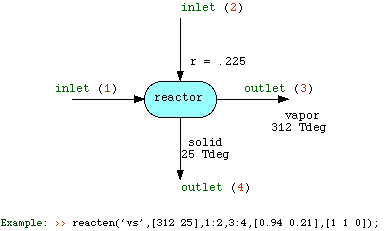
 |
function hdif=reacten(s,tmp,in,out,rs,t)
% Reacten: General purpose reactor module
% function hdif=reacten(s,tmp,in,out,rs,t)
% General purpose reactor module:
% The number of inlet and exit streams can be any integer >0.
% Argument List:
% Argument Gives
% s vector of states of the exit stream(s).
% ('v', 'l', or 's')
% tmp temperatures of exit streams in Tdeg.
% in the indices of the inlet stream(s).
% out the indices of the exit stream(s).
% rs the reaction rates.
% t The fraction of each compound in the product
% that goes into each stream, except that the
% last stream need not be given. Each row should
% correspond to one exit stream. If tmp and out
% are scalars, t does not need to be given.
% reacten returns the sum of the enthalpies of the
% exit streams minus the sum of the enthalpies
% of the inlet streams.
% Ex: reacten('vs',[312 25],1:2,3:4,[.94 0.21],[1 1 0]);
%
% JWD, SHD & OKB, TYLC
%
global ne stoic
nstr=length(out);
if nstr==1
% If there is only one exit stream, use reacte.
if length(tmp)~=1
% Check first to see that there is exactly one exit temperature
disp('The number of streams out is one, but the length of tmp is:')
disp(length(tmp))
return
end
hdif=reacte(s,tmp,in,out,rs)
return
end
if nargin<=5
disp('Your number of exit streams is:')
disp(nstr)
disp('You must give the fraction of each compound out for all except')
disp('the last of those streams as a sixth argument.')
end
[nrt,nct]=size(t);
if nrt==nstr-1 & nrt>0
% the zeros in the line below are included so that sum sums columns
% when t is a vector and there are two exits.
t=[t;1-sum([t;zeros(1,nct)])];
end
sne=size(ne);
nc=sne(2)-3;
% these zeros are needed for the same reason as above
NS=sum([ne(in,4:(nc+3));zeros(1,nc)]);
nout=NS+(rs*stoic);
k=find(abs(nout)>eps);
str=ne(in(1),:);
setne(s(1),in(1),tmp(1),nout(k),k)
if nstr>1
for j=2:nstr
sepe(s(j),s(1),tmp(j),tmp(1),in(1),out([j 1]),t(j,:));
end
rem=nout.*t(1,:);
l=find(abs(rem)>eps);
setne(s(1),out(1),tmp(1),rem(l),l);
ne(in(1),:)=str;
end
hdif=sum(ne(out,3))-sum(ne(in,3));
Also see The Reactor Functions: reacte, reacten. Back to Chapter 5.